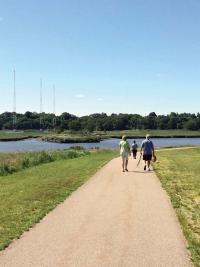June 24, 2015
 Pope John Paul II Park's a contrast to the bustle of life around it. Charlie Dorf photosThink about it. The Neponset River Esplanade, extending from Lower Mills to The Estuary at Port Norfolk. An esplanade is defined as a park that serves as a promenade along a shore, and the opportunity now exists for one in Dorchester with the clearing of land bordering the river in Port Norfolk.
Pope John Paul II Park's a contrast to the bustle of life around it. Charlie Dorf photosThink about it. The Neponset River Esplanade, extending from Lower Mills to The Estuary at Port Norfolk. An esplanade is defined as a park that serves as a promenade along a shore, and the opportunity now exists for one in Dorchester with the clearing of land bordering the river in Port Norfolk.
In a very thoughtful response to my recent article on Pope John Paul II Park, the science teacher Mary Lyons pointed out that the reservation was designed to be a “passive park” reflecting the natural state of the riverfront estuary but modified to allow limited recreational use. If limited use means discouraging visitors, it’s working. If there is a balance to be struck between the park’s ecosystems and the public, the public is losing so far.
Take a walk along the Charles and imagine similar amenities along the Neponset: boating, fishing, sunbathing, and picnicking in the summer; an arts festival; flower and vegetable gardens; kite flying, volley ball, baseball, and soccer. In the winter, cross-country skiing and ice skating on an artificial pond. The Neponset has all the potential one sees realized along the Charles and more. I applaud the work that Ms. Lyons and others did to create the park. Like her, I don’t want to see it overrun; I just want more people to have the opportunity to enjoy it.
To achieve that promise some basic improvements are necessary. The park must be more family friendly. There are no bathroom facilities (only three porta-potties are available to the public). There is no place in the park to buy something to eat – not even a food truck. Without food and clean restrooms, few people come to the park to eat and those that do often stay in their cars.
The poor maintenance of the park shows a lack of concern for Dorchester residents. The Department of Conservation & Recreation (DCR) could never get away with that kind of neglect along the Charles. I assume DCR is underfunded and thus has to prioritize limited resources. Unfortunately, it’s easier to shortchange an agency responsible for maintaining public spaces rather than those providing direct services to people.
However, other states with the same problems do a far better job maintaining their parks. Lack of funds too often becomes an easy excuse for doing less. Doing more with less is not likely to produce budget increases so the tendency of agencies is to slack off and blame it on insufficient funding.
Private sponsorship and volunteers, if used creatively, could fill some of the gaps, but DCR must become more directly involved. Perhaps the commissioner should consider making regular, unannounced, personal inspections of sites to assure that necessary work is being done. Challenging the usual excuses for non-performance is essential for effective leadership.
In my experience, workers sometimes use “understaffing” as an excuse for poor performance. Sometimes they convince themselves that they are overwhelmed, and instead of trying harder, they do less. Most of us perform better when there is some pressure to do so. With no pressure, we often take the course of least resistance.
With all due respect, perhaps naming the park for a pope – even one about to be declared a saint – was not a good idea. Pope John Paul II had no involvement in the park’s creation. He never visited the site and likely never heard of it. If it was to be named after a person, I can think of many deserving Bostonians. But my preference would have been “The Neponset River Esplanade,” particularly in light of its better-known sister river, a little farther north. That name describes what it is. It honors a beautiful place, one dedicated to recreation, relaxation, and contemplation.
The questions we should be asking are: Why does the Charles River Esplanade get all the attention? Is it because it’s downtown rather than in a neighborhood? Is it because the Charles is the city’s front door while the overlooked Neponset is the back door?
Perhaps the answer to why the Charles gets more attention is because it gets more use. And indeed it does, due in large part to the fact that it is better maintained and more user friendly. It embraces the community it serves, inviting residents to enjoy its amenities.
The Neponset park has no bathrooms, no boathouse, no gardens, no flowers, no shade trees, no place to buy a hot dog, and few picnic tables. It does have a lot of grass, much of which is overgrown and weed-filled. In my experience, it also has few workers.
The park was a great idea. It has great potential, but it’s lonely. In my opinion, the pleasure of more people enjoying it will only enhance its natural beauty.
James W. Dolan is retired Dorchester District Court judge who now practices law.

